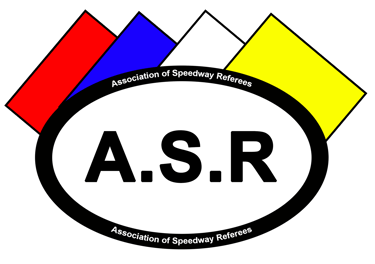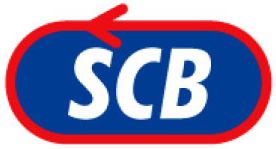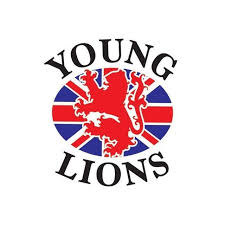

ROLE OF THE REFEREE
The referee allocated to all SCB speedway fixtures carry out a wide range of duties beyond starting heats and making potentially controversial decisions!
The referee's work starts prior to the day of the meeting. Team line ups are posted by the home promotion three days in advance of a fixture. The referee checks the line ups and makes sure that all riders are licenced and have the correct averages. They also check to make sure that any absences and facilities are in accordance with the speedway regulations. The referee will also review the previous meeting report(s) to review any issues had been raised by previous referees attending the stadium. This helps to inform track inspection activities when at the stadium.
The meeting referee has supreme control of a meeting as soon as they enter and sign on at the stadium. They undertake a range of activities in the two hours prior to the start time. This includes meeting with the home promoter, the Clerk of the course, both team managers for league meetings, machine examiner(s), track curator, start marshals and medical team. Sometimes referees will also hold short team briefings to talk to riders.
The main job on arrival is to carry out a track inspection. This involves checking that the circuit is compliant with the homologation certificate. This sets out the size of the track, the type of fence, the neutral zones, lighting, infield zones and details around the number and type of APD bags and the number and type of stop lights and sirens. It also details any specific local circumstances, for example, if grading equipment is permitted to remain on the infield. Checks are also made in the pits (e.g. fire extinguishers and buckets, waste oil containers etc.) and the riders' changing rooms to ensure that they have access to showers and clean changing facilities.
In addition to checking that the track is compliant with the homologation certificate, the referee carries out an inspection of the track to ensure that there are no additional hazards or issues with the track. One example is that referees check to ensure that the APD clips are connected. This often involves checking under the APD skirt and behind the APD. If you see a referee walking outside of the circuit, the connection of the rear APD clips and the attachment of the APD to the safety fence is what is being checked - along with making sure that the neutral zone is clear of any obstructions.
The referees will also check the referee panel in the box to make sure that the box works, the lights and sirens work and that the tapes release correctly. The dedicated teams at tracks around the country play a vital part in helping to rectify any issues that the referees may raise in these pre-meeting checks. Before the meeting starts, they collect the essential meeting certificate and technical forms. These are signed by relevant personnel to confirm that they have completed all activities needed to allow the meeting to commence.
Whilst referees are in supreme control of a meeting, they have no organisational responsibility for the meeting. This means that promoters are free to organise the meeting in the way they deem appropriate. This includes aspects such as the parade and grading breaks. As referee, one of the roles is to work collaboratively with the promoter to ensure that the meeting runs smoothly and so that the referee knows when the grading breaks will take place. In the Premiership, this takes place after heats 4, 7, 11 and 14.
At the dedicated meeting start time, the two minutes will be sounded. Referee panels vary from track to track. Some are FIM panels, others a series of switches. When the two minutes is sounded the clock on the centre green counts down. At some tracks this is done automatically when the two minute button is pressed, at others there are separate buttons and switches that need to be pressed and at others the clock is operated by track staff on the infield. This is one example of how panels can increase or decrease the workload of a referee prior to the start of a race. Once riders are in line at tapes and the start marshal walks away, the green light is operated and at most tracks the random start system releases the tapes (usually with a delay of between 1.5 to 2.5 seconds). At some tracks not only do referees have to switch on the green light, they also need to press the random start button to ensure that the tapes release. In addition at some tracks the 2 minute flashing amber light needs to be manually switched off and after the tapes are released the green light may need to be manually switched off too. At some tracks, this means that in the first few seconds of a race, along with watching for movement at the start and any first bend incidents there is a lot of flicking (the right) switches to do. Hopefully after four clean racing laps, the referee declares the result to the announcer, the time is confirmed by the transponder system (or timekeeper) and the result and time recorded in the referee's programme.
During a meeting, referees can also deal with other issues. These may include liaising with the Clerk of the Course when there is a change to a line up of a heat, when medical treatment of a rider is needed, or when a team manager wants to speak on the phone. Occasionally, the referee has to deal with failures of systems, for example a failure of a starting gate or failure of the red light system to stop a race. When these things happen, the referee has to decide whether the meeting can continue to run safely and the processes that need to be in place. When decided, the referee needs to brief riders and/or track staff so that there is clarity about what has been put in place.
Once the meeting has reached the end, the referee's job is still not over. Documentation from the meeting, including withdrawal documentation is collated and a meeting report is submitted. This details the score, changes to the line ups, the number of fallers and withdrawals from the meeting, any issues from the track inspection which the next referee needs to be aware of and any issues reported from the machine examiners. This is all emailed to the SCB by noon on the day following the meeting. Occasionally referees also have to ensure that motorcycles or equipment that are subject to a protest are securely impounded for future examination or take away helmets that have been impounded as a result of damage.
So, you see, a referee does more than start a race and disqualify riders. We play an essential role in making sure that our tracks are safe and compliant for meetings to take place.
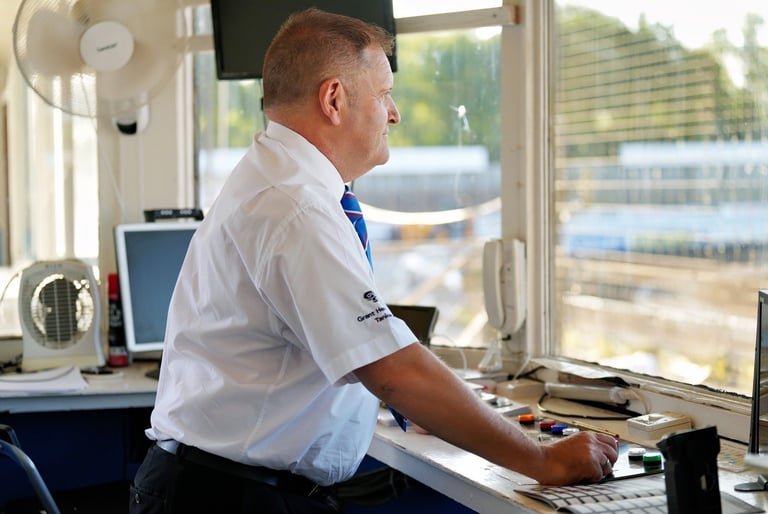

Image courtesy Stephen Waller Photography
After a pause of no more than two minutes, the sequence starts again and we are off for heat 2! When there is an incident, referees will view replays where they are available. The referee does not always have the control of what images are seen. Referees officiating TNT TV meetings generally have a direct link to the TV director and can request specific camera angles and real-time / slow-mo replays. This can also be the case at some BSN meetings too. While access to replays in the box is improving, we do occasionally have to leave the box to view them in another area of the stadium.
NexT ARTICLE:
BACK TO REFEREE INFO MAIN PAGE:
Discussions with the Clerk of the Course are one of the most important aspects of officiating a meeting.
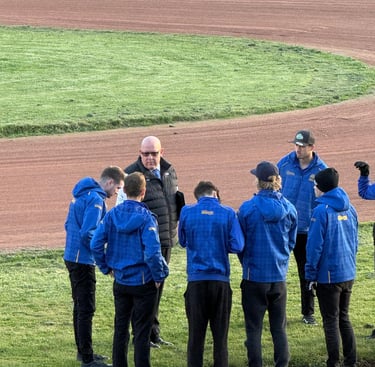

A rider briefing prior to the start of a meeting.
Ready to start a race.
